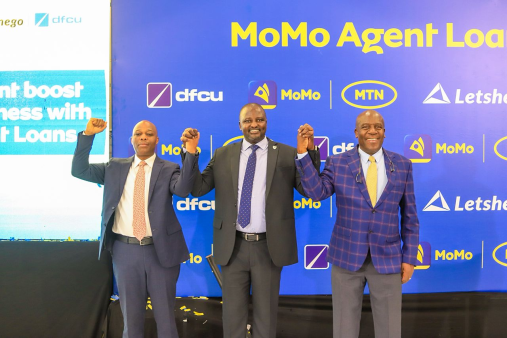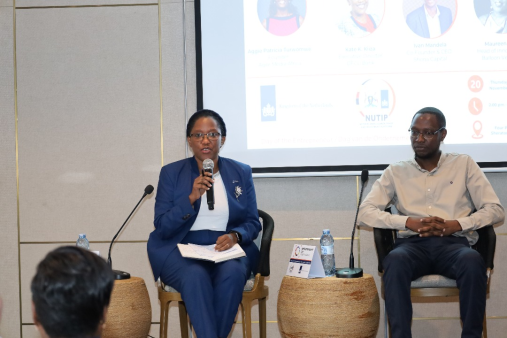When dfcu Bank in January 2017, acquired Crane Bank, then one of the five largest Banks in Uganda, for UGX200 billion, it had been hoped that dfcu’s market share fortunes would greatly turn around, possibly allowing dfcu to permanently break into the top 3 banks by assets, profitability and lending.
Thanks to the acquisition, that very same year, dfcu Bank moved from the 6th largest bank by customer deposits to the second largest; the 4th largest by lending to the 3rd largest; the 5th largest by assets to the second position and from the 7th most profitable to the 2nd most profitable bank in Uganda.
But over the next 5 years, the bank, for various reasons failed to defend its market share and by the end of 2022, it had nearly lost most of the advantages gained from the acquisition. The bank had slid to the 6th largest by deposits and assets, the 5th largest by lending and the 9th by profits!
While the bank was still one of the Domestic Systemically Important Banks (D-SIBs), it was at a crossroads, still wrestling with high non-performing loans, stifled shareholder value growth, legacy technology infrastructure, low customer satisfaction and thin investor confidence. Competition too was getting tighter, with a looming possibility of further losing market share.
Two years later, that narrative has flipped — and dramatically so.
At an investor and stakeholder briefing held on Tuesday, 1st April 2025, dfcu Bank Chief Executive Officer Charles Mudiwa stood before a packed room on the bank’s 7th-floor rooftop terrace with a message that was both confident and clear:
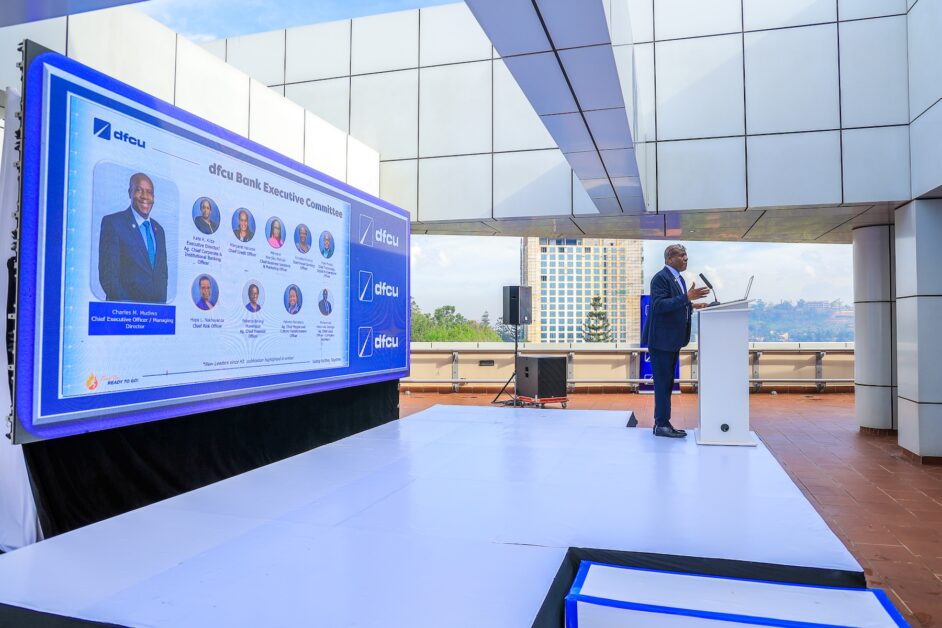
“I think there’s no denying that we went through a rough patch and the numbers were not good,” he said, before quickly adding that those tough times were over.
“Is dfcu out of the woods? We believe we are. We can see the turnaround from the 2023 and 2024 performance. We can now see the journey; we are clear that we are moving on the right path, and we have a very clear focus, a clear direction and a clear strategy. We have the right level of team, a really a strong leadership team, which I believe is capable of delivering the results that we require. They are focused, clear and dedicated to ensuring that this vision actually happens and that we will deliver it. So yes, dfcu is out of the woods,” Mudiwa emphatically reassured stakeholders.
And the numbers back him up.
For the year ended December 31, 2024, dfcu Limited delivered a landmark financial performance, posting a profit after tax of UGX 72.1 billion, up from UGX 28.7 billion in 2023. This represents a growth of UGX 43.4 billion, or 151% year-on-year, marking the Group’s strongest recovery in years. The turnaround was primarily driven by the exceptional performance of its principal subsidiary, dfcu Bank Limited, which delivered outstanding results in profitability, credit quality, and balance sheet strength.
In 2024, dfcu Bank recorded a profit after tax of UGX 75.1 billion, rising sharply from UGX 34 billion in 2023. This represents a growth of UGX 41.1 billion, equivalent to a 121% increase in annual profit.
This was on the back of growth in assets from UGX 3.2 trillion in 2023 to UGX 3.47 trillion in 2024, an increase of UGX 270 billion, representing 8.2% growth. The main driver of this growth was a UGX 341.4 billion increase in investment securities, which expanded from UGX 968.6 billion to UGX 1.31 trillion—a 35.3% increase. This strategic pivot toward high-yield, low-risk government securities enhanced income stability and improved the Group’s liquidity and interest margin management.
Customer deposits also showed signs of recovery, growing from UGX 2.32 trillion in 2023 to UGX 2.36 trillion in 2024, a UGX 36 billion increase, or 1.6% growth. This followed a contraction of 3.7% the previous year and signalled that depositor confidence was beginning to rebound. The Bank also maintained a healthy deposit composition, with 75% of deposits in Current and Savings Accounts (CASA)—a favourable structure in a rising interest rate environment.
| Indicator | 2022 Performance | 2023 Performance | Growth (%) in 2023 | 2024 Performance | Growth (%) in 2024 |
| Profit After Tax (UGX billion) for dfcu Bank | 30.6 | 34 | 11.1% | 75.1 | 120.9% |
| Profit After Tax (UGX billions) for dfcu Limited (Group) | 29.48 | 28.72 | -2.6% | 72.087 | 151.0% |
| Earnings Per Share (EPS in UGX) | 39.4 | 38.39 | -2.6% | 96.35 | 151.0% |
| Dividend per Share (Proposed in UGX) | 8.19 | 9.1 | 11.1% | 20.09 | 120.8% |
| Dividend Paid (Actual UGX billion) | 6.13 | 6.13 | 0.0% | 15.01 | 144.9% |
| Customer Deposits (Trillion UGX) | 2.41 | 2.32 | -3.7% | 2.36 | 1.7% |
| Loans & Advances (Net trillion in UGX) | 1.36 | 1.13 | -16.9% | 1.13 | 0.0% |
| Loan Losses / Impairment UGX billions) | -88.2 | -82.7 | -6.2% | 12 | -114.5% |
| Non-Performing Loan Ratio (NPL %) | 7.6% | 9.2% | 21.1% | 4.4% | -52.2% |
| NPA Ratio (%) | 8% | 9% | 12.5% | 4% | -55.6% |
| Credit Loss Ratio (%) | 6.5% | 7.3% | 12.3% | 1.1% | -84.9% |
| Non-performing loans and other assets (UGX billions) | 108.2 | 107.7 | -0.5% | -100.0% | |
| Return on Equity (ROE) | 5% | 4% | -20.0% | 10% | 150.0% |
| Return on Assets (ROA) | 1% | 1% | 0.0% | 2% | 100.0% |
| Total Assets (UGX trillion) | 3.28 | 3.2 | -2.4% | 3.5 | 9.4% |
| Total Income (UGX billions) | 431.7 | 449.2 | 4.1% | 455.4 | 1.4% |
| Tax Contribution (UGX billions) | 83.3 | 98.9 | 18.7% | 100 | 1.1% |
| Community Investment (UGX billion) | 1.1 | 1.3 | 18.2% | 1.5 | 15.4% |
| Core Capital (UGX billions) | 532.2 | 507.7 | -4.6% | 519.7 | 2.4% |
| Core Capital (%) | 28.2% | 28.8% | 2.1% | 29.1% | 1.0% |
| Total Capital (%) | 29.1% | 29.5% | 1.4% | 29.8% | 1.0% |
| Liquidity Asset Ratio (%) | 32.2% | 39.0% | 21.1% | 34.2% | -12.3% |
On the lending front, dfcu Bank’s net loans and advances remained flat at UGX 1.13 trillion in both 2023 and 2024. At first glance, this may suggest stagnation—but as CEO Charles Mudiwa clarified during the April 2025 investor briefing, this was a deliberate and strategic decision in line with the bank’s broader transformation agenda.
“We were very clear about not to be wanting to start to be aggressive in our lending growth as we fix the business,” he said adding: “We spent a lot of time last year, as our chief credit officer has explained fixing the business and collecting what was due to us”. — Charles Mudiwa
Charles Mudiwa attributed the bank’s cautious lending appetite not only to an internal focus on cleaning up its credit book but also to muted demand in the broader economy. “I think of concern, of course, is particularly the decline in private sector credit growth… it’s an area that all of us are concerned about,” he said, emphasizing the need for new approaches to spur lending.
Rebecca Birungi Muwanguzi, the Ag. Chief Financial Officer explained the bank opted to “do a lot of selective lending with a focus on the SME portfolio”.
“These SME portfolios are usually short-term and small ticket-size facilities,” she added.
This disciplined stance enabled the Bank to sharply reduce its non-performing loan (NPL) ratio from 9.5% to 4.4%, a 52.2% improvement year-on-year, and turn what had been UGX 82.7 billion in impairments in 2023 into a UGX 12 billion net recovery in 2024—a dramatic swing of UGX 94.7 billion or 114.5% improvement. Likewise, the credit loss ratio dropped from 7.3% to 1.1%, reflecting an 84.9% reduction and indicating a healthier, better-performing loan book.
In addition, the interest in suspense—which reflects uncollected income from defaulted loans—fell from UGX 15 billion in 2023 to UGX 2.9 billion in 2024, confirming improved repayment performance.
The upgraded credit assessment tools, tighter underwriting policies, and aggressive recoveries on legacy non-performing assets, coupled with a renewed focus towards non-funded income, selective lending, and investment in high-yielding government securities — a rebalancing strategy that paid off in 2024. Net interest income rose by 4%, from UGX 259.2 billion in 2023 to UGX 269.3 billion, buoyed by disciplined portfolio growth and increased returns from government securities. Fees and commissions improved by 2% to UGX 66.5 billion, reflecting rising customer activity on digital and physical channels.
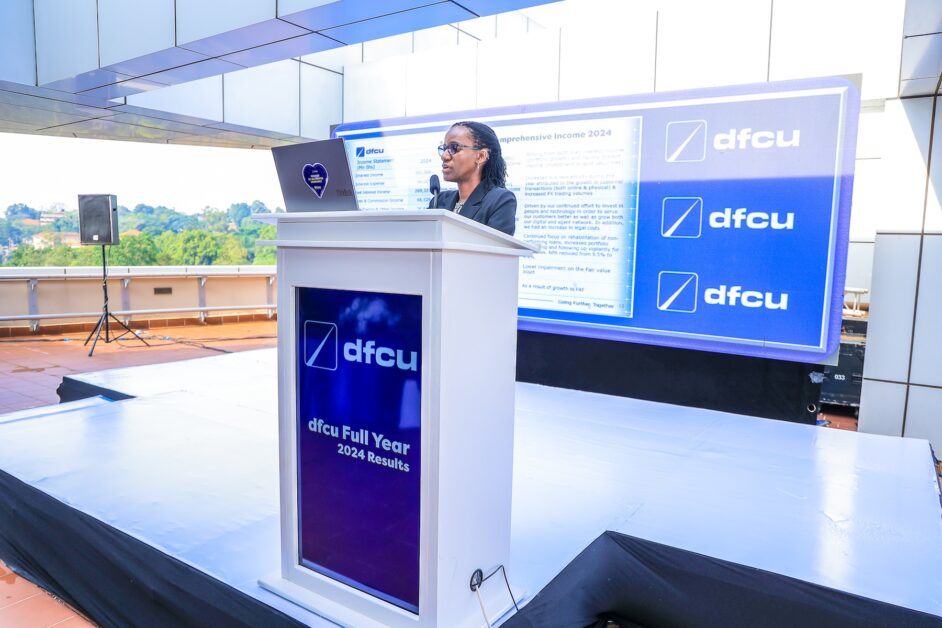
As a result, total income rose to UGX 455.4 billion up from UGX 449.2 billion in 2023, a modest 1.4% increase, driven primarily by improvements in net interest income and steady fee-based revenue streams. While operating expenses grew by 18% to UGX 292.6 billion, due to strategic investments in digital platforms, leadership talent, and infrastructure upgrades, the bank still retained a strong margin to deliver significant bottom-line growth. The combination of income resilience, impairment recoveries, and improved operational execution allowed dfcu to report a 151% jump in net profit, from UGX 34 billion in 2023 to UGX 75.1 billion in 2024.
dfcu’s strong performance in 2024 was underpinned not just by internal efficiencies, but by a clear shift in customer behaviour and sentiment. More customers are not only banking with dfcu — they’re transacting more, staying longer, and recommending the bank to others. In 2024, customer transaction volumes increased by 37%, a clear sign of rising engagement across both physical and digital channels. This surge in activity was matched by an equally impressive improvement in customer sentiment, with the bank’s Net Promoter Score (NPS) — a key measure of customer loyalty and willingness to recommend — rising by 20 percentage points. “Our customers are transacting with us more… and believing in our story,” CEO Charles Mudiwa noted, emphasizing that this growth is driven by service enhancements and product innovations that are resonating with clients.
Rewind: Charles Mudiwa’s Fired-Up Warcry
When Charles Mudiwa took the helm at dfcu Bank in April 2023, he arrived with a reputation for transformation — a seasoned executive known across Africa for turning around banking institutions through bold strategy and disciplined execution. With over 26 years of experience in financial services, including two decades at the Standard Bank Group, Mudiwa brought not only a depth of expertise but also a proven ability to deliver results.
At Stanbic Bank Kenya, where he served as CEO prior to joining dfcu, he more than doubled the bank’s profitability over five years, growing net profit from KES 4.3 billion in 2017 to KES 9.1 billion by the end of 2022. Under his leadership, the bank’s deposits, lending, total income, and total assets all grew by more than 60%, positioning Stanbic Kenya as a highly competitive, digitally agile, and resilient institution even through the COVID-19 pandemic.
Prior to that, he had held the top job at Stanbic Bank Zambia, where he led the institution to become the most profitable and most awarded bank in the country. He also previously headed Standard Bank Malawi and held senior roles at Standard Bank South Africa, including Director for Mass Markets.
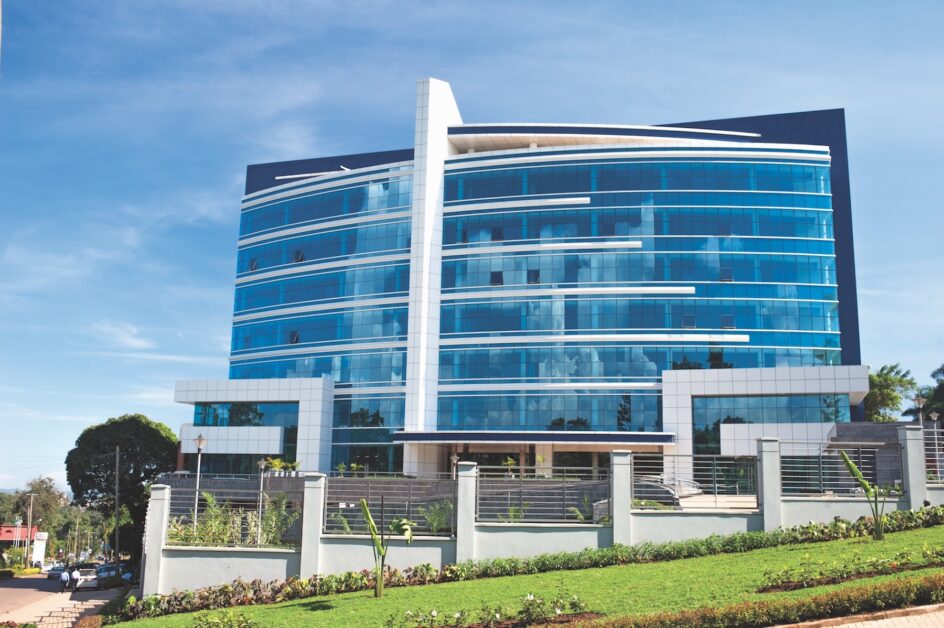
Recognizing the need for a fresh strategic direction, Mudiwa launched an ambitious turnaround plan under the banner of the “Fired-Up” strategy — a comprehensive organisational refresh designed to restore dfcu’s growth momentum, customer focus, and market leadership.
The Fired-Up strategy was more than just a rallying cry — it was a structured transformation blueprint grounded in four paradigms: refocus, reorganize, re-engineer, and reignite. At its heart was a firm belief that dfcu could only achieve sustainable stakeholder value by aligning its institutional purpose, operational capacity, and human capital with the needs of a rapidly evolving economy. The strategy’s aim, Mudiwa said, was to clarify “where we play and how we shall win,” with a commitment to digitally enabled innovation, financial inclusion, and operational efficiency. Sector specialization became a cornerstone of this vision.
Mudiwa and his team mapped out eight critical sectors in Uganda’s economy where the bank would build focused capability: agriculture, manufacturing, infrastructure and energy, ICT, trade and business, the public sector, financial institutions, and education and health. These sectors were embedded into dfcu’s customer segments — from corporate and institutional to commercial, enterprise, and personal banking — allowing for more targeted service delivery and deeper client relationships.
But strategy alone does not win wars — people do. And to deliver this transformation, Mudiwa undertook a comprehensive reorganization of the bank’s executive leadership, assembling what he described as a “glocal” team — professionals with both local insight and global experience, capable of navigating Uganda’s complex banking environment while benchmarking against international best practices.
One of the first major appointments was that of Kate Kiiza, who had served as Chief Financial Officer since 2015 and was promoted to Executive Director and CFO in August 2023. Kiiza brought over 14 years of financial leadership experience, including roles at Shell Uganda (now Vivo Energy) and United Bank for Africa, and had long been seen as a stabilizing force within the bank.
In the critical credit function, Mudiwa recruited Margaret Karume as Chief Credit Officer. With more than 30 years in banking across East Africa, Karume had previously served as Managing Director of NIC Bank Tanzania (now NCBA) and held senior risk roles at Barclays Bank Kenya (now Absa), where she managed corporate banking portfolios. Her deep regional experience in credit risk and portfolio management proved key in cleaning up dfcu’s loan book and instilling stronger lending discipline.
In the corporate and institutional banking space, Mudiwa brought on board Doreen Byaruhanga, a career banker with over 20 years of experience, who had previously held senior positions at Barclays, Stanbic, and Equity Bank. At Stanbic Bank Uganda, she led corporate and institutional banking as well as asset finance, while at Equity Bank she headed the corporate division.
To spearhead innovation and customer experience, Maryann Wanjiku Michuki was tapped as Chief Business Solutions and Marketing Officer. A dynamic executive with over 15 years of experience across financial services, telecommunications, and digital marketing, Michuki had previously worked at Safaricom, led the advisory arm of WPP’s Squad Digital, and served in senior innovation and brand roles at Stanbic Bank Kenya. Her multidisciplinary background gave her the edge to rethink customer engagement and digital transformation at dfcu.
On the retail banking side, Annette Kiconco joined as Chief Retail Officer. Kiconco brought over two decades of frontline experience in retail and commercial banking, having held key roles at Absa Bank, Orient Bank (now I&M), and most recently at Stanbic Bank Uganda, where she headed public sector business and commercial clients.
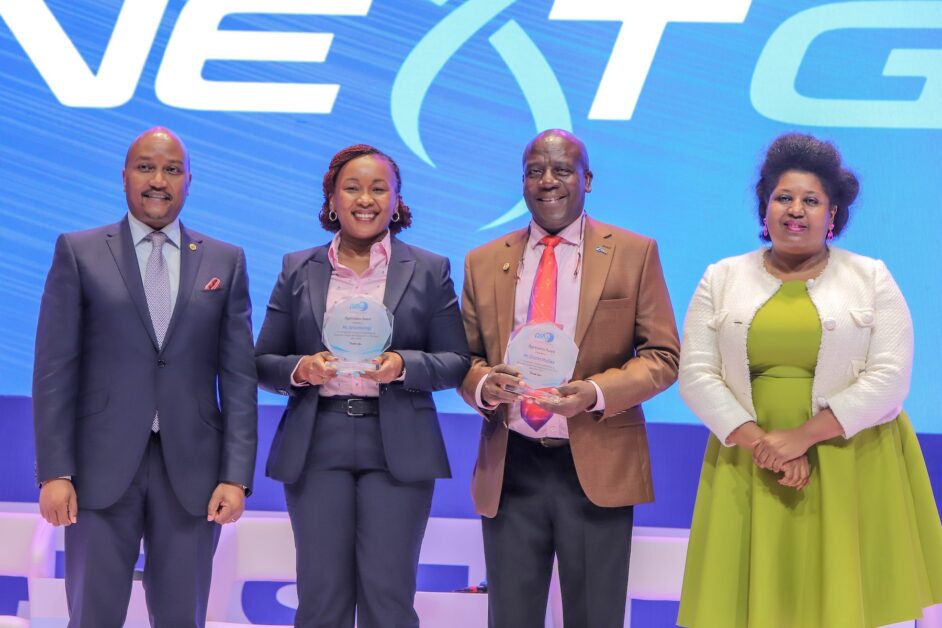
Most recently, Mudiwa also hired Musa Musazi, as dfcu Bank’s Chief Technology, Digital & Operations Officer in August 2024. He is a seasoned technology executive with over two decades of experience driving digital transformation, infrastructure innovation, and operational excellence across Africa. Before joining dfcu, he served as Group Chief Technology Officer at Google’s CSquared, where he oversaw technology strategy, implementation, and operations across six countries — Uganda, Ghana, Kenya, Liberia, DRC, and Togo. There, he championed the rollout of open-access shared ICT infrastructure, positioning CSquared as a catalyst for internet connectivity and digital inclusion across the continent. His earlier roles at MTN Uganda, Warid Telecom, and CelTel Uganda gave him deep operational and technical expertise in network design, engineering, and project execution in high-growth, high-demand environments. With this rare blend of technical depth, leadership experience, and continental perspective, Musa is now spearheading dfcu’s digital transformation journey — leading efforts to modernize core banking systems, drive automation, and scale digital service delivery as a core enabler of the bank’s Fired-Up strategy.
While much of 2023 was spent sharpening the axe — reshaping strategy, rebuilding teams, and resetting systems — Mudiwa still managed to steer the bank toward some important quick wins by year-end. dfcu grew its active customer base by 103%, driven in part by its participation in the government’s Parish Development Model (PDM). Transaction volumes rose by 17%, and digital banking uptake jumped 33%, particularly in mobile banking. The bank revamped its ATM network, rolling out 78 deposit-taking ATMs and expanding its agent banking network by 15% — a key milestone after completely overhauling the previously unreliable agent platform. While dfcu took a cautious stance on new credit, reducing its loan book by 17.3%, it still increased the number of active borrowers by 19%, reflecting broader access to credit. Importantly, the bank posted a net profit of UGX 34 billion — an 11.1% increase from the previous year — and maintained a strong capital position, with core and total capital ratios rising to 28.9% and 29.5% respectively, well above regulatory thresholds.
From Stabilisation to Acceleration: dfcu Bank’s 2024 Breakout Year
While 2023 marked a period of stabilisation and strategic groundwork at dfcu Bank, 2024 was the year growth roared back. Under Charles Mudiwa’s leadership and the full rollout of the Fired-Up strategy, the bank transitioned from cautious recovery to strong financial resurgence, with nearly every key metric accelerating at a pace far beyond the gains seen in the previous year.
For example, while in 2023, dfcu Bank’s profit after tax rose modestly by 11.1%, reaching UGX 34 billion, in 2024, that figure more than doubled to UGX 75.1 billion, representing a 120.9% increase, the bank’s best profit in 7 years since the UGX 127 post Crane Bank acquisition windfall.
It is also the second highest in the bank’s 60 years history. For the wider dfcu Limited group, profit after tax jumped by an astounding 151%, from UGX 28.7 billion to UGX 72.1 billion, a clear indicator of the bank’s return to strong, consolidated profitability.
From modest early wins in 2023 to accelerated gains in 2024, dfcu’s performance clearly demonstrates that the “Fired-Up” strategy had shifted from planning to execution — and execution to resurgence.
In terms of shareholder value, the contrast between 2023 and 2024 was stark. Earnings per share (EPS) had dipped slightly in 2023, falling by 2.6% to UGX 38.39. But in 2024, they more than doubled, rising by 151% to UGX 96.35, reflecting a surge in profitability. The proposed dividend per share followed the same trajectory: a modest 11.1% increase in 2023 was eclipsed by a 121% increase in 2024, from UGX 9.10 to UGX 20.09. Most notably, the total dividend payout, which remained flat in 2023 at UGX 6.13 billion, soared to UGX 15.01 billion in 2024, a 144.9% jump — sending a strong signal of confidence to shareholders.
dfcu also made significant strides in efficiency. In 2023, Return on Equity (ROE) had declined by 20%, a reflection of transitional strain. But in 2024, ROE rose sharply from 4% to 10%, a 150% increase, demonstrating more efficient capital deployment. Return on Assets (ROA) remained flat at 1% in 2023, but doubled to 2% in 2024, showing improved productivity and earnings relative to the bank’s asset base.
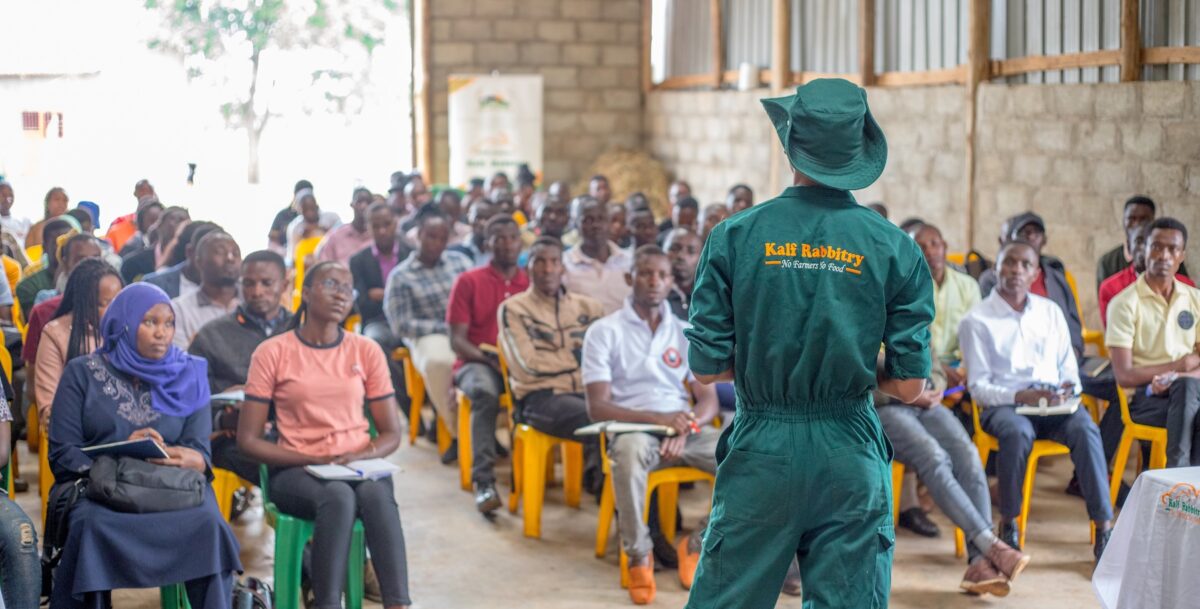
Perhaps most remarkable was dfcu’s leap in resilience and risk management. The credit book, long a drag on performance, was decisively cleaned up. In 2023, loan impairments were reduced by 6.2%, from UGX 88.2 billion to UGX 82.7 billion. But in 2024, dfcu posted a UGX 12 billion net recovery, marking a 114.5% reversal. The Non-Performing Loan (NPL) ratio, which had worsened by 21.1% in 2023, improved dramatically in 2024 — down by 52.2% to 4.4%, restoring confidence in the quality of the loan portfolio. The credit loss ratio, which had increased by 12.3% in 2023, fell by 84.9% in 2024, reinforcing the strength of dfcu’s new credit controls and aggressive recovery strategy.
Importantly, these gains did not come at the expense of balance sheet integrity. Core capital stood at 29.1% and total capital at 29.8%, well above regulatory thresholds, even as dfcu continued to invest in leadership talent, digital platforms, and branch automation.
Transforming Lives and Businesses: dfcu’s Impact Beyond Banking
Beyond financial performance, dfcu Bank reinforced its commitment to environmental, social, and governance (ESG) principles by scaling its impact-driven initiatives across the country. In 2024, dfcu invested UGX 1.5 billion in corporate social responsibility (CSR) programmes, targeting financial literacy, education, women empowerment, and agribusiness development. Through its rebranded dfcu Foundation, the bank trained over 27,000 smallholder farmers and entrepreneurs, supported 402 enterprises — 54% of which were women-led — and impacted over 40,000 lives directly and 100,000 lives indirectly. As part of its 60th anniversary celebrations, dfcu launched “60 Acts of Kindness”, a grassroots staff-led initiative that mobilized UGX 80 million in personal contributions, reaching 10,000 beneficiariesacross Uganda. Additionally, under the GROW programme for women entrepreneurs, dfcu disbursed UGX 11.2 billion to 212 beneficiaries across 60 districts, conducted 60 financial literacy sessions, and provided technical assistance to 118 women-led businesses. These milestones reflect the bank’s deeply embedded purpose of transforming lives and businesses in Uganda, positioning ESG and inclusive growth at the heart of its long-term strategy.
Fired-Up for the Future and Into the Fast Lane: dfcu Sets Bold Targets for 2025 and Beyond
Mudiwa is however quick to admit that dfcu’s 2024 growth was not as “phenomenal, as we would like it to”, because he believes what is ahead is far much greater.
“dfcu is a work in progress. We are building the future, and we believe that we are turning around the corner,” he said, emphasizing that the modest top-line gains are just the beginning of a deeper transformation.
The sharp rise in profitability, improving asset quality, and greater customer engagement point to a bank that is steadily regaining its footing after years of restructuring. “The story has just begun,” Mudiwa told stakeholders at this week’s briefing, underlining that the gains made so far validate the direction of the strategy, even as the full impact is yet to unfold. For him, 2024 was less about explosive growth and more about solidifying the foundation for long-term value creation — with dfcu now positioned to shift from recovery to acceleration.
“The numbers, as they say, don’t lie,” he reckoned.
Looking ahead, CEO Charles Mudiwa has laid out a clear and confident roadmap anchored in four strategic pillars that will sustain the momentum built in 2024 and propel the institution toward its long-term aspirations. “We are currently transforming the business by rebuilding technology,” Mudiwa said, “and we’ve identified four key pillars that will get us into the future as we drive our strategy.”
At the heart of this strategy is sector specialization — a deliberate focus on the key economic sectors that are shaping Uganda’s development. “We’ve identified this, and we’re very clear about how we drive each of the key economic sectors through an ecosystem plan that will drive the business going forward into those sectors,” Mudiwa explained. This approach will see dfcu deepening its presence and capability in areas like agriculture, manufacturing, energy, ICT, oil & gas and trade — aligning financial solutions to sector-specific needs and growth dynamics.
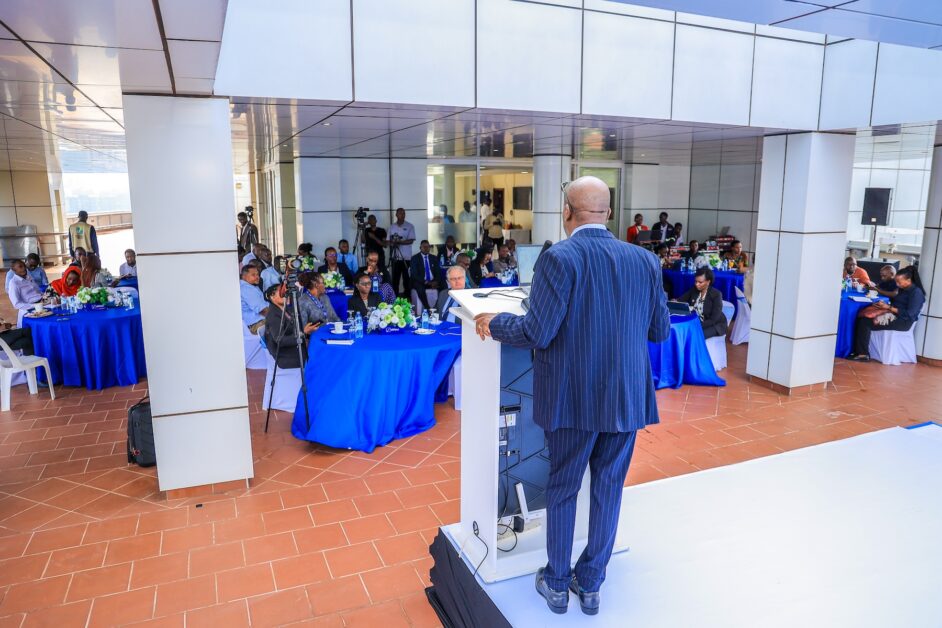
The second pillar is customer intimacy — building deeper, data-informed relationships that go beyond transactional engagement. Citing the bank’s improved customer Net Promoter Score, which rose by 20 percentage points in 2024, Mudiwa emphasized: “We believe that by staying close to our customers, building a strong customer relationship network, and being intimate with our customers, we actually can grow the business.” This signals a sharpened focus on user experience, responsiveness, and relationship-driven service.
The third area of strategic focus is technology. With digital transformation now a central driver of competitive banking, dfcu is investing heavily in modernizing its infrastructure. “We are in the age of AI. How do we leverage technology?” Mudiwa reflected, framing the bank’s ambitions. “We are modernizing our technology, we are automating our core processes, and we are resetting our cost base so we actually have a much more efficient cost base and strategy that allows us to drive our agenda.” From core banking upgrades to data-driven decision-making, tech will be the engine of scale and speed.
The fourth and final pillar is culture — particularly cultivating a high-performing, agile, and evidence-based organization. “We are transforming dfcu into a new and agile-driven bank,” Mudiwa said. “We will make agile our way of working, and that’s how we deliver the solutions, and that’s how the strategy is and will be delivered.” The leadership team is also committed to embedding sustainability at the core of the bank’s purpose.
Mudiwa has also set a clear shareholder value ambition: to double its return on equity (ROE) from 10% in 2024 to 20% by 2026. “Our ambition is that we want to give an internal equity of 20%, so by the end of next year, we should double that to 20%,” Mudiwa promised. This is coupled with a target to significantly reduce the cost-to-income ratio (CIR)—moving it from the high 60s toward the mid-60s and closer to the 50s.
Perhaps most aspirational is dfcu’s goal to re-enter the top five most profitable banks in Uganda by 2026. “We aspire to be between the top five banks in terms of profitability,” Mudiwa said. “That’s the future that we are looking at, and that’s what we’re planning as dfcu. We want to give confidence to our investors, our shareholders and our stakeholders… We have clarity about the direction we’re going, and we believe we can deliver this.”
This conviction is reinforced by the bank’s strong capitalisation, renewed leadership, and cultural reset. “We believe we are out of the woods,” Mudiwa declared. “We can see the turnaround… we are clear that we are moving on the right path, with a very clear focus, clear direction, and clear strategy,” he reiterated.
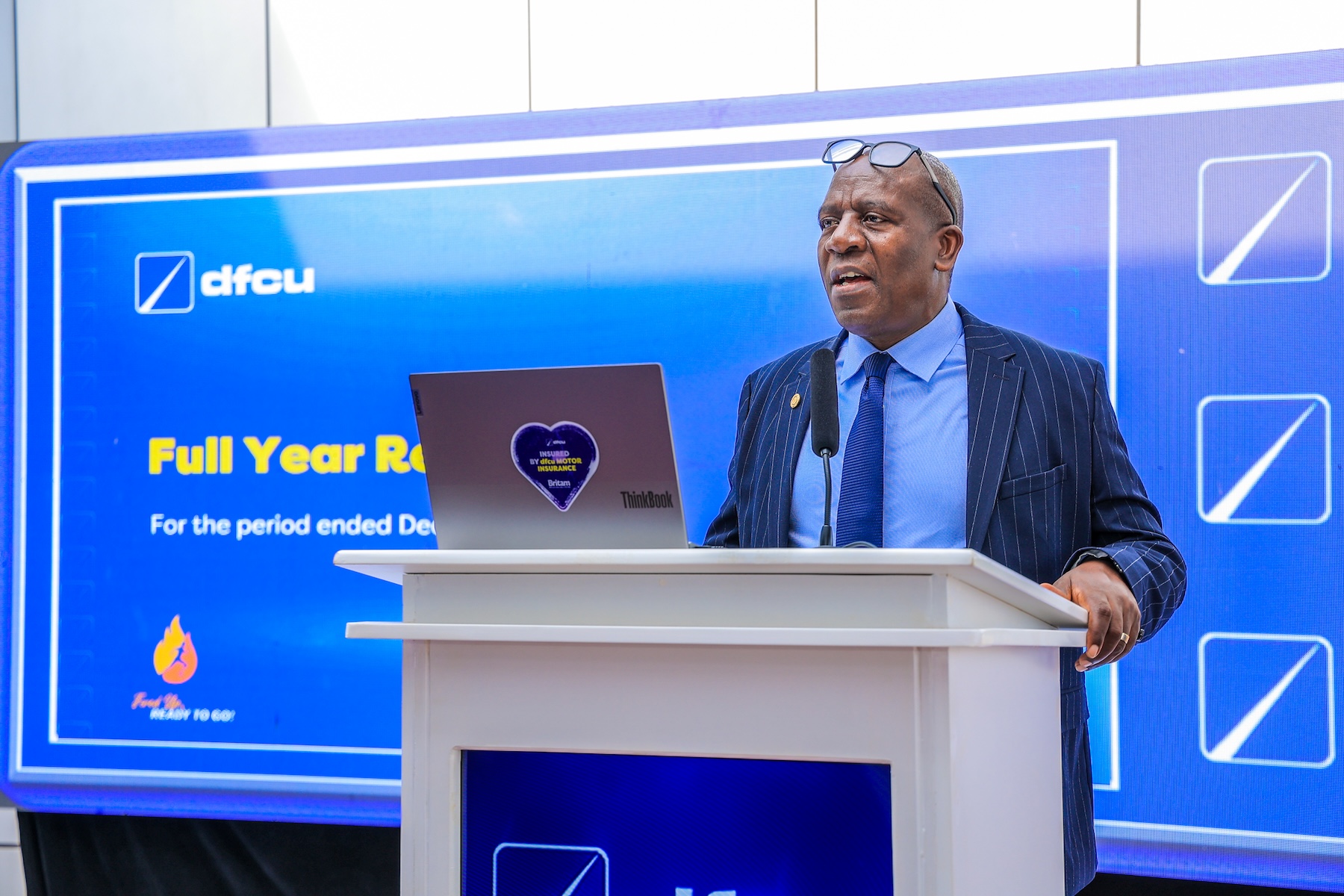
 Letters to My Younger Self: Humphrey Asiimwe—"Ambition Without Purpose Leads Nowhere"
Letters to My Younger Self: Humphrey Asiimwe—"Ambition Without Purpose Leads Nowhere"

